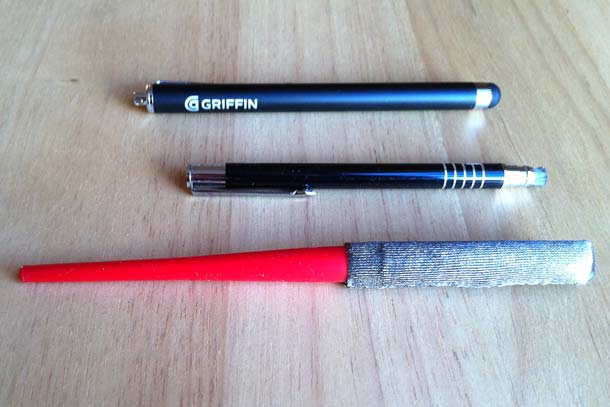Peldi tipped me to this graphic deconstructing one of Apple's promotional emails.
http://www.flowtown.com/blog/wp-content/uploads/2011/01/110110-FLOW-APPLE.png
Peldi tipped me to this graphic deconstructing one of Apple's promotional emails.
http://www.flowtown.com/blog/wp-content/uploads/2011/01/110110-FLOW-APPLE.png

[Update: This review was updated after getting the latest version of the Stylus Socks.]
My search for the perfect stylus for sketching on the iPad is over. I've tried ever stylus I could get my hands on. The three finalists that earned a space on my desk or pocket in the past year have been the iClooly, the Stylus Socks, and the Griffin Stylus for iPad.
I started out initially playing with a few rubber tipped styli and the Pogo Sketch. I had to hack the Pogo Sketch to make it glide, which I still think is an elegant hack. I even contacted the creator about my hack but he didn't seem to care much for the idea of having a plastic nib inserted in the conductive foam, so I gave up on that. All of the rubber tipped styli created too much friction to be useful, and I didn't see much promise in the hacks that involved scraping a metal snap across my glass screen. After those experiences I set out to find the perfect stick to take out with me to supplement sketching on paper.
I have 2 main criteria by which I judged the styli.
iClooly ($14.95)
The iClooly uses a small, soft metallic brush tip that seemed to glide the smoothest on the screen, but the metal stick is too thin and short to use comfortably for more than the shortest sketching sessions. I used this consistently for at least 6 months and found it exceptional. I came up with an inelegant hack to extend the stick, and that served me well, but who wants to use an ugly hacked stick?
Stylus Socks II ($7)
The Stylus Socks II sold by Shapedad on Etsy are a clever solution that wraps the end of a plastic KOH-I-NOOR pen holder with a conductive fabric. My initial review of the Stylus Sock was based on my use of a prototype version, but I've since received the final version which includes a felt tip under the fabric. The best thing about this stylus is the long stick, which makes it the most usable of the bunch. At only $7 a stylus, this may be the best choice for the budget-conscious sketcher. It works very well and it feels good to support an independent maker. At this price I think this may be the perfect solution for most people. One thing I would like is a heavier version. I may try to purchase a metal pen holder and move the fabric over to that one.
Shapedad is also working on a prototype mouthstick for people who don't have use of their arms, prompted by a request to make a long stylus for a quadriplegic customer. You can watch his progress in his Flickr photostream.
Griffin iPad Stylus ($18.99)
Someone finally tipped me to the Griffin iPad Stylus in November and I started watching the videos of users on YouTube and was easily convinced that it could be smooth enough. I was skeptical at first, but the rubber tip is surprisingly untacky and glides smoothly with little friction. It's slightly less smooth than the iClooly, but the biggest positive is that the stick is thicker and resembles the thickness of a pen or marker. It feels great in the hand, and it's long enough to reach from my closed index finger and thumb to rest between the two fingers. The clip slides nicely onto the spine of my iPad cover.
The Griffin was my initial winner among the three. Although it's the most expensive, it works well and I like the metal stick, which I found to be the right thickness. The clip also helps me keep it tethered to the iPad case. After I received the final version of the Stylus Socks II that included the felt tip under the fabric, I found this stylus to be equally as effective as the Griffin, and glides more smoothly. I think they're both good choices.
I still find sketching on paper superior to sketching on the iPad, but there are definite advantages to immediately having an image to share digitally. iPad sketching has a permanent place in my toolkit, and the Griffin is my weapon of choice. Hopefully this will be the last in this year-long series on finding the right tool for this task.
I stumbled on Paul Irish and Divya Manian's HTML5 Boilerplate after looking for a solution to fall back on a local jQuery library if Google's CDN ever went south, and reading about how to use this technique for WordPress. Ben Kutil also helped me undersand how the fallback technique works a little bit, and I tested and implemented on Balsamiq's site.
HTML5 Boilerplate is not a library, but a template and set of awesome examples for how to get started integrating HTML 5 into your sites. They provide techniques for future-proofing HTML/CSS/JS, with cross-browser normalization, performance optimizations, even optional features like cross-domain Ajax and Flash in mind. They also give you a starter apache .htaccess config file with caching rules and prep your site to serve HTML5 video, use @font-face, and use gzip.
Check out HTML5 Boilerplate. You can also watch a screencast of Paul Irish demonstrating it on Nettuts.